2014 LINCOLN MKZ HYBRID light
[x] Cancel search: lightPage 280 of 445

•
Do not store the kit unsecured inside
the passenger compartment of the
vehicle as it may cause injury during a
sudden stop or crash. Always store the
kit in its original location.
• After sealant use, the tire pressure
monitoring system sensor and valve
stem on the wheel must be replaced
by an authorized Ford dealer.
• When inflating a tire or other objects,
use the black air hose only. Do not use
the transparent hose which is designed
for sealant application only.
• Operating the kit could cause an
electrical disturbance in radio, CD, and
DVD player operation.
What to do when a Tire Is Punctured
A tire puncture within the tire's tread area
can be repaired in two stages with the kit.
• In the first stage, the tire will be
reinflated with a sealing compound
and air. After the tire has been
reinflated, you will need to drive the
vehicle a short distance (about 4 miles
[6 kilometers]) to distribute the sealant
in the tire.
• In the second stage, you will need to
check the tire pressure and adjust, if
necessary, to the vehicle's tire inflation
pressure. First Stage: Reinflating the Tire with
Sealing Compound and Air WARNINGS
Do not stand directly over the kit
while inflating the tire. If you notice
any unusual bulges or deformations in the
tire's sidewall during inflation, stop and call
roadside assistance. If the tire doesn't inflate to the
recommended tire pressure within
15 minutes, stop and call roadside
assistance. Preparation: Park the vehicle in a safe,
level and secure area, away from moving
traffic. Turn the hazard lights on. Apply the
parking brake and turn the engine off.
Inspect the flat tire for visible damage.
Sealant compound contains latex. To avoid
any allergic reactions, use the non-latex
gloves located in the accessory box on
the underside of the kit housing.
Do not remove any foreign object that has
pierced the tire. If a puncture is located in
the tire sidewall, stop and call roadside
assistance.
1. Remove the valve cap from the tire
valve.
2. Unwrap the clear tube from the compressor housing.
3. Remove the tube cap and fasten the metal connector of the tube to the tire
valve, turning clockwise. Make sure
the connection is tightly fastened.
278
MKZ (CC9) Wheels and Tires
Page 284 of 445
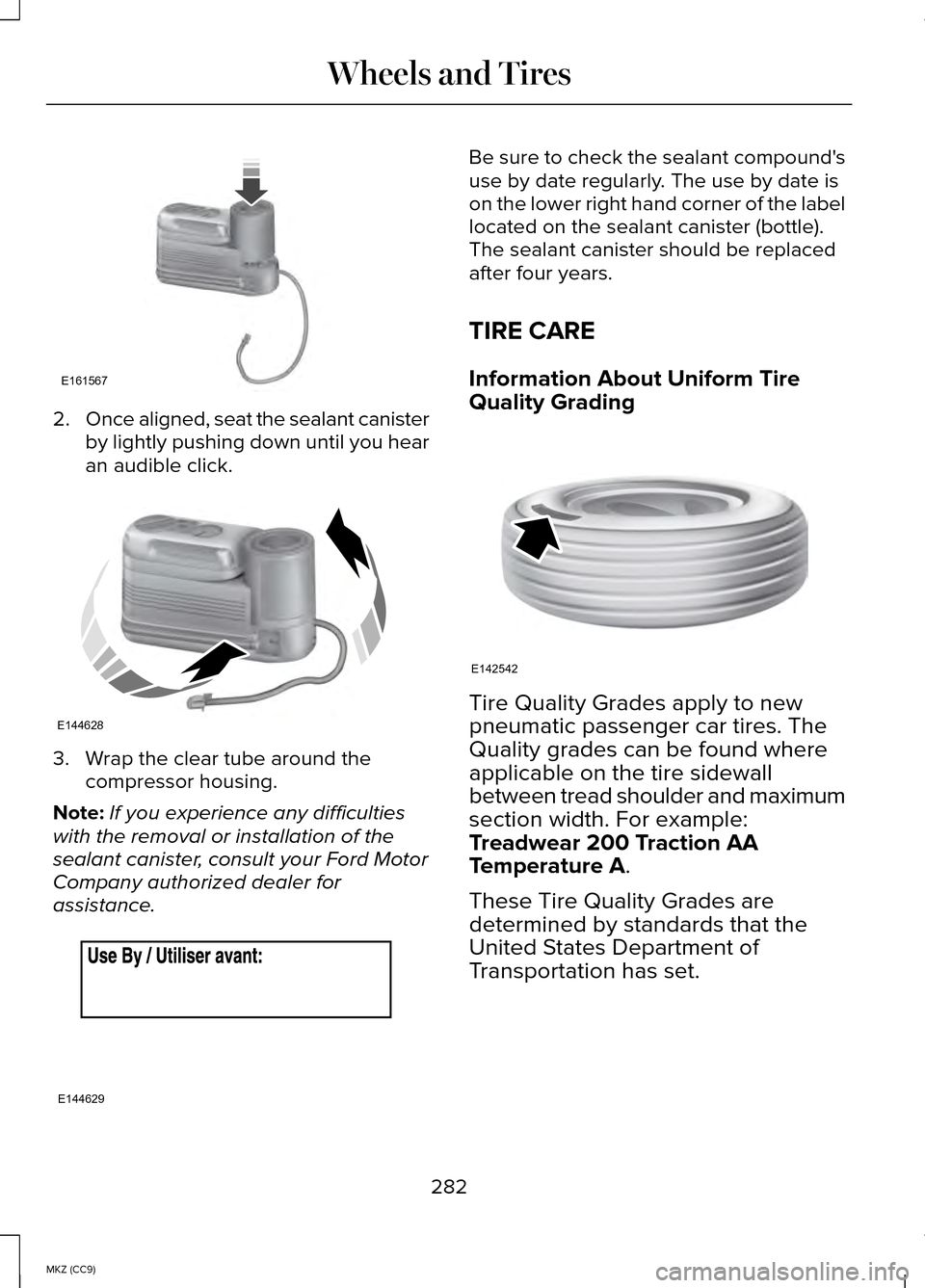
2.
Once aligned, seat the sealant canister
by lightly pushing down until you hear
an audible click. 3. Wrap the clear tube around the
compressor housing.
Note: If you experience any difficulties
with the removal or installation of the
sealant canister, consult your Ford Motor
Company authorized dealer for
assistance. Be sure to check the sealant compound's
use by date regularly. The use by date is
on the lower right hand corner of the label
located on the sealant canister (bottle).
The sealant canister should be replaced
after four years.
TIRE CARE
Information About Uniform Tire
Quality Grading
Tire Quality Grades apply to new
pneumatic passenger car tires. The
Quality grades can be found where
applicable on the tire sidewall
between tread shoulder and maximum
section width. For example:
Treadwear 200 Traction AA
Temperature A.
These Tire Quality Grades are
determined by standards that the
United States Department of
Transportation has set.
282
MKZ (CC9) Wheels and TiresE161567 E144628 E144629 E142542
Page 285 of 445
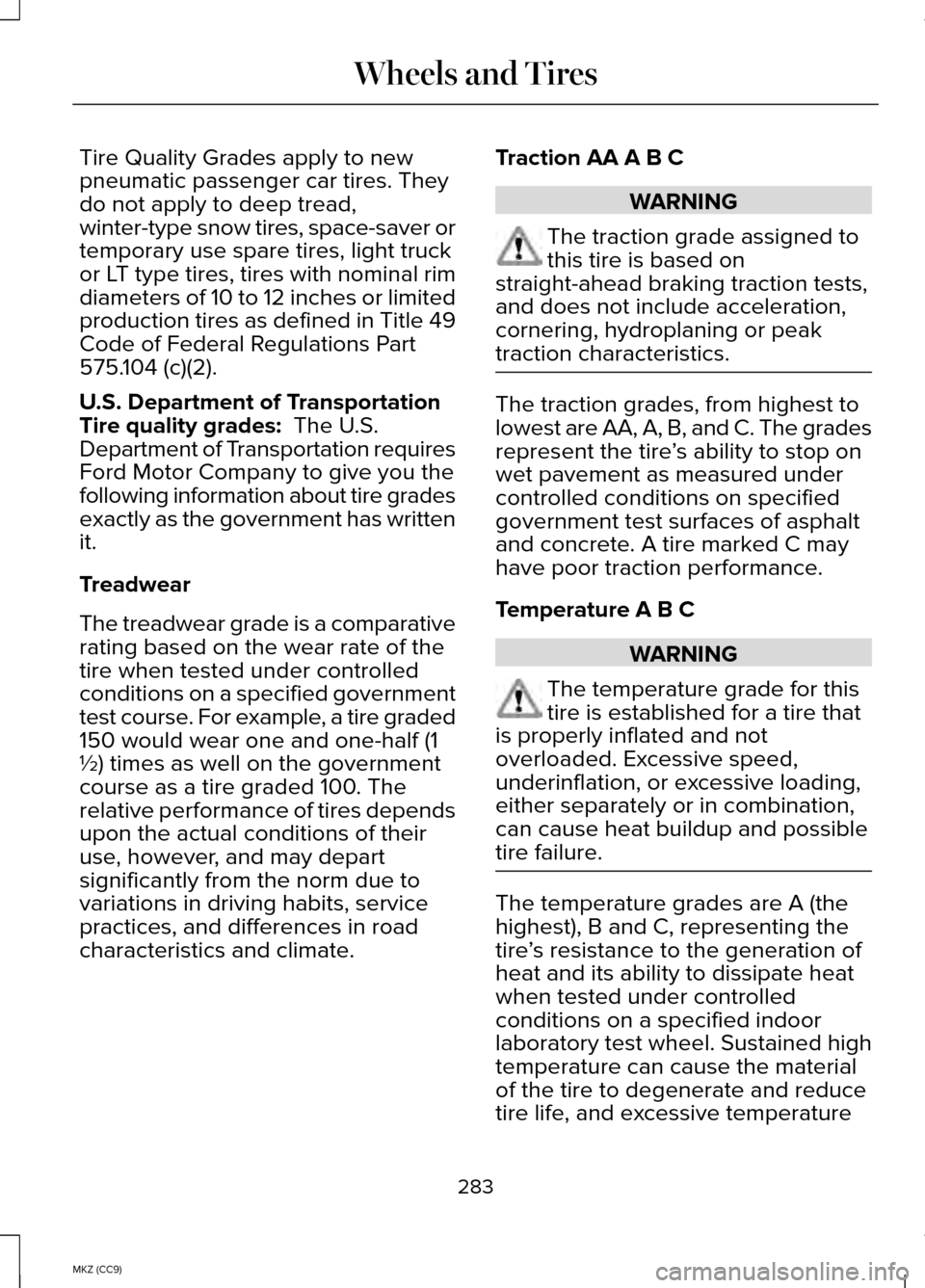
Tire Quality Grades apply to new
pneumatic passenger car tires. They
do not apply to deep tread,
winter-type snow tires, space-saver or
temporary use spare tires, light truck
or LT type tires, tires with nominal rim
diameters of 10 to 12 inches or limited
production tires as defined in Title 49
Code of Federal Regulations Part
575.104 (c)(2).
U.S. Department of Transportation
Tire quality grades: The U.S.
Department of Transportation requires
Ford Motor Company to give you the
following information about tire grades
exactly as the government has written
it.
Treadwear
The treadwear grade is a comparative
rating based on the wear rate of the
tire when tested under controlled
conditions on a specified government
test course. For example, a tire graded
150 would wear one and one-half (1
½) times as well on the government
course as a tire graded 100. The
relative performance of tires depends
upon the actual conditions of their
use, however, and may depart
significantly from the norm due to
variations in driving habits, service
practices, and differences in road
characteristics and climate. Traction AA A B C WARNING
The traction grade assigned to
this tire is based on
straight-ahead braking traction tests,
and does not include acceleration,
cornering, hydroplaning or peak
traction characteristics. The traction grades, from highest to
lowest are AA, A, B, and C. The grades
represent the tire
’s ability to stop on
wet pavement as measured under
controlled conditions on specified
government test surfaces of asphalt
and concrete. A tire marked C may
have poor traction performance.
Temperature A B C WARNING
The temperature grade for this
tire is established for a tire that
is properly inflated and not
overloaded. Excessive speed,
underinflation, or excessive loading,
either separately or in combination,
can cause heat buildup and possible
tire failure. The temperature grades are A (the
highest), B and C, representing the
tire
’s resistance to the generation of
heat and its ability to dissipate heat
when tested under controlled
conditions on a specified indoor
laboratory test wheel. Sustained high
temperature can cause the material
of the tire to degenerate and reduce
tire life, and excessive temperature
283
MKZ (CC9) Wheels and Tires
Page 286 of 445
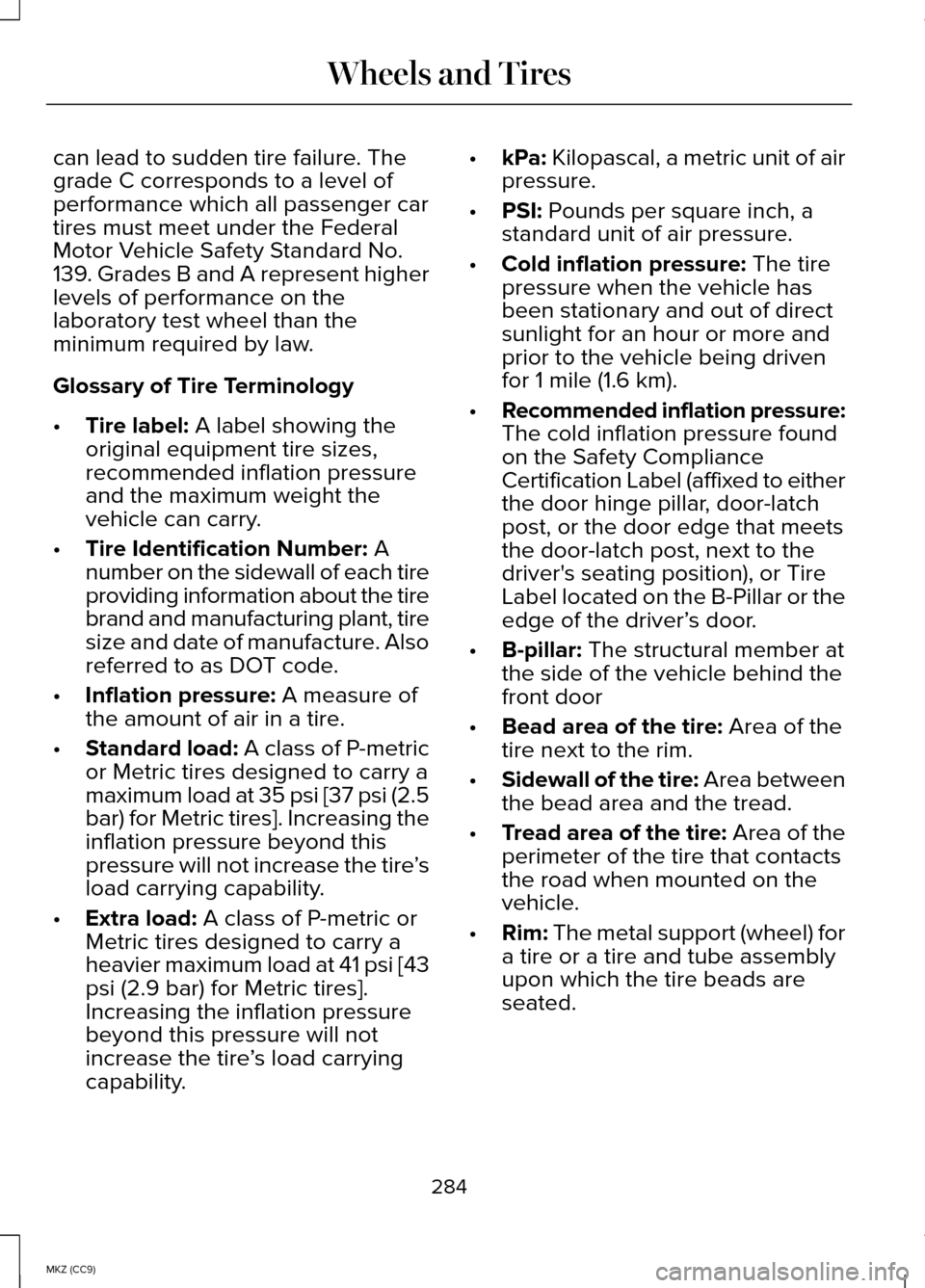
can lead to sudden tire failure. The
grade C corresponds to a level of
performance which all passenger car
tires must meet under the Federal
Motor Vehicle Safety Standard No.
139. Grades B and A represent higher
levels of performance on the
laboratory test wheel than the
minimum required by law.
Glossary of Tire Terminology
•
Tire label: A label showing the
original equipment tire sizes,
recommended inflation pressure
and the maximum weight the
vehicle can carry.
• Tire Identification Number:
A
number on the sidewall of each tire
providing information about the tire
brand and manufacturing plant, tire
size and date of manufacture. Also
referred to as DOT code.
• Inflation pressure:
A measure of
the amount of air in a tire.
• Standard load:
A class of P-metric
or Metric tires designed to carry a
maximum load at 35 psi [37 psi (2.5
bar) for Metric tires]. Increasing the
inflation pressure beyond this
pressure will not increase the tire ’s
load carrying capability.
• Extra load:
A class of P-metric or
Metric tires designed to carry a
heavier maximum load at 41 psi [43
psi (2.9 bar) for Metric tires].
Increasing the inflation pressure
beyond this pressure will not
increase the tire ’s load carrying
capability. •
kPa:
Kilopascal, a metric unit of air
pressure.
• PSI:
Pounds per square inch, a
standard unit of air pressure.
• Cold inflation pressure:
The tire
pressure when the vehicle has
been stationary and out of direct
sunlight for an hour or more and
prior to the vehicle being driven
for 1 mile (1.6 km).
• Recommended inflation pressure:
The cold inflation pressure found
on the Safety Compliance
Certification Label (affixed to either
the door hinge pillar, door-latch
post, or the door edge that meets
the door-latch post, next to the
driver's seating position), or Tire
Label located on the B-Pillar or the
edge of the driver’ s door.
• B-pillar:
The structural member at
the side of the vehicle behind the
front door
• Bead area of the tire:
Area of the
tire next to the rim.
• Sidewall of the tire: Area between
the bead area and the tread.
• Tread area of the tire: Area of the
perimeter of the tire that contacts
the road when mounted on the
vehicle.
• Rim:
The metal support (wheel) for
a tire or a tire and tube assembly
upon which the tire beads are
seated.
284
MKZ (CC9) Wheels and Tires
Page 287 of 445

Information Contained on the Tire
Sidewall
Both U.S. and Canada Federal
regulations require tire manufacturers
to place standardized information on
the sidewall of all tires. This
information identifies and describes
the fundamental characteristics of the
tire and also provides a U.S. DOT Tire
Identification Number for safety
standard certification and in case of a
recall.
Information on P Type Tires
P215/65R15 95H is an example of a
tire size, load index and speed rating.
The definitions of these items are
listed below. (Note that the tire size,
load index and speed rating for your
vehicle may be different from this
example.) A. P: Indicates a tire, designated by
the Tire and Rim Association, that may
be used for service on cars, sport
utility vehicles, minivans and light
trucks. Note: If your tire size does not
begin with a letter this may mean it is
designated by either the European
Tire and Rim Technical Organization
or the Japan Tire Manufacturing
Association.
B.
215: Indicates the nominal width of
the tire in millimeters from sidewall
edge to sidewall edge. In general, the
larger the number, the wider the tire.
C. 65: Indicates the aspect ratio which
gives the tire's ratio of height to width.
D.
R: Indicates a radial type tire.
E.
15: Indicates the wheel or rim
diameter in inches. If you change your
wheel size, you will have to purchase
new tires to match the new wheel
diameter.
F.
95: Indicates the tire's load index.
It is an index that relates to how much
weight a tire can carry. You may find
this information in your owner’ s
manual. If not, contact a local tire
dealer.
Note: You may not find this
information on all tires because it is
not required by federal law.
G.
H: Indicates the tire's speed rating.
The speed rating denotes the speed
at which a tire is designed to be driven
for extended periods of time under a
standard condition of load and
inflation pressure. The tires on your
vehicle may operate at different
285
MKZ (CC9) Wheels and TiresH
I
J
KL
M
A
B
CDEFG
E142543
Page 289 of 445
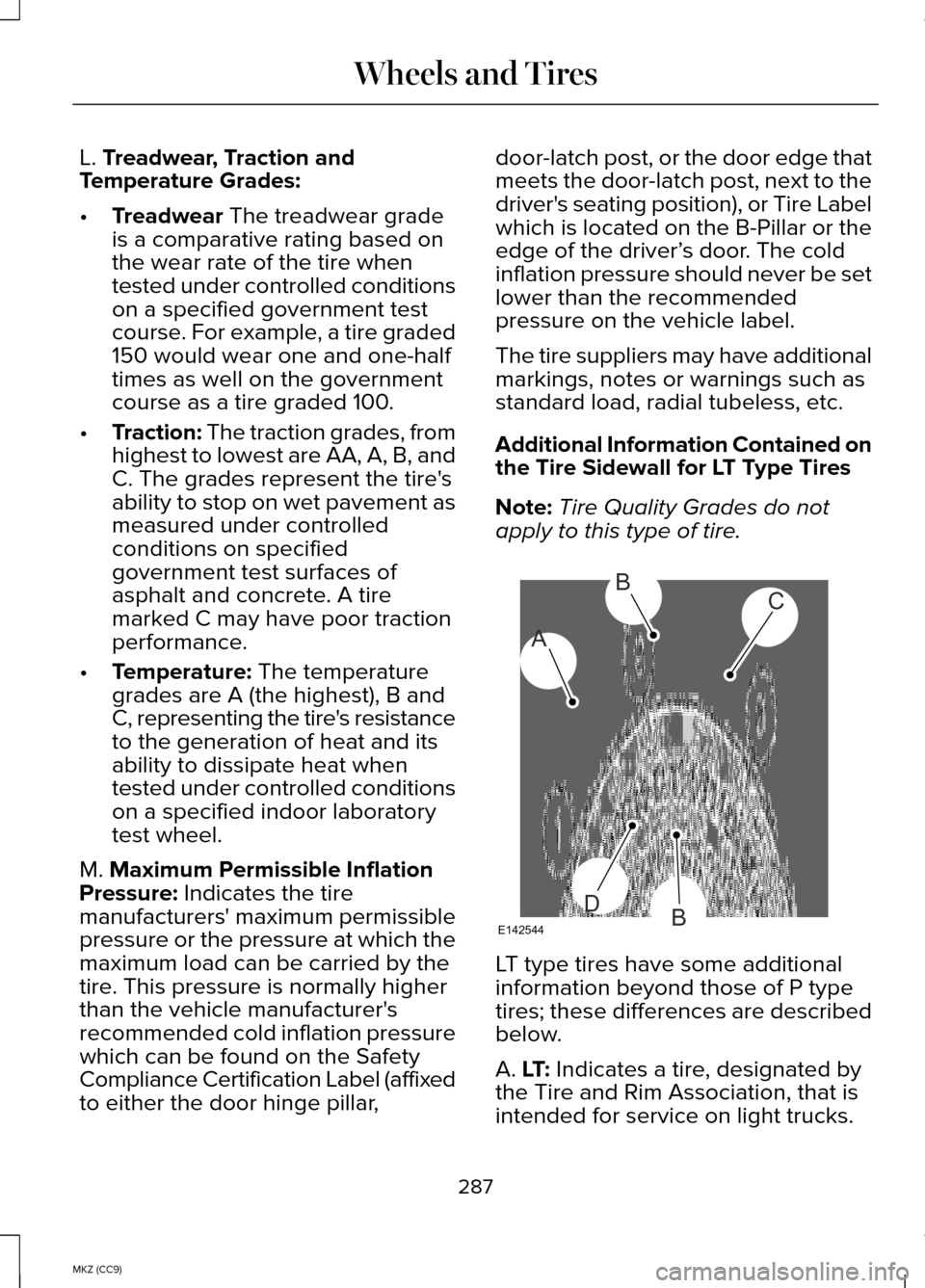
L. Treadwear, Traction and
Temperature Grades:
• Treadwear
The treadwear grade
is a comparative rating based on
the wear rate of the tire when
tested under controlled conditions
on a specified government test
course. For example, a tire graded
150 would wear one and one-half
times as well on the government
course as a tire graded 100.
• Traction: The traction grades, from
highest to lowest are AA, A, B, and
C. The grades represent the tire's
ability to stop on wet pavement as
measured under controlled
conditions on specified
government test surfaces of
asphalt and concrete. A tire
marked C may have poor traction
performance.
• Temperature:
The temperature
grades are A (the highest), B and
C, representing the tire's resistance
to the generation of heat and its
ability to dissipate heat when
tested under controlled conditions
on a specified indoor laboratory
test wheel.
M.
Maximum Permissible Inflation
Pressure: Indicates the tire
manufacturers' maximum permissible
pressure or the pressure at which the
maximum load can be carried by the
tire. This pressure is normally higher
than the vehicle manufacturer's
recommended cold inflation pressure
which can be found on the Safety
Compliance Certification Label (affixed
to either the door hinge pillar, door-latch post, or the door edge that
meets the door-latch post, next to the
driver's seating position), or Tire Label
which is located on the B-Pillar or the
edge of the driver’
s door. The cold
inflation pressure should never be set
lower than the recommended
pressure on the vehicle label.
The tire suppliers may have additional
markings, notes or warnings such as
standard load, radial tubeless, etc.
Additional Information Contained on
the Tire Sidewall for LT Type Tires
Note: Tire Quality Grades do not
apply to this type of tire. LT type tires have some additional
information beyond those of P type
tires; these differences are described
below.
A.
LT: Indicates a tire, designated by
the Tire and Rim Association, that is
intended for service on light trucks.
287
MKZ (CC9) Wheels and TiresA
BC
BDE142544
Page 290 of 445

B. Load Range and Load Inflation
Limits: Indicates the tire's
load-carrying capabilities and its
inflation limits.
C. Maximum Load Dual lb (kg) at psi
(kPa) cold:
Indicates the maximum
load and tire pressure when the tire
is used as a dual; defined as four tires
on the rear axle (a total of six or more
tires on the vehicle).
D.
Maximum Load Single lb (kg) at
psi (kPa) cold: Indicates the maximum
load and tire pressure when the tire
is used as a single; defined as two
tires (total) on the rear axle.
Information on T Type Tires
T145/80D16 is an example of a tire
size.
Note: The temporary tire size for your
vehicle may be different from this
example. Tire Quality Grades do not
apply to this type of tire. T type tires have some additional
information beyond those of P type
tires; these differences are described
below:
A.
T: Indicates a type of tire,
designated by the Tire and Rim
Association, that is intended for
temporary service on cars, sport utility
vehicles, minivans and light trucks.
B.
145: Indicates the nominal width of
the tire in millimeters from sidewall
edge to sidewall edge. In general, the
larger the number, the wider the tire.
C. 80: Indicates the aspect ratio which
gives the tire's ratio of height to width.
Numbers of 70 or lower indicate a
short sidewall.
D.
D: Indicates a diagonal type tire.
288
MKZ (CC9) Wheels and TiresA
BCDE
E142545
Page 300 of 445
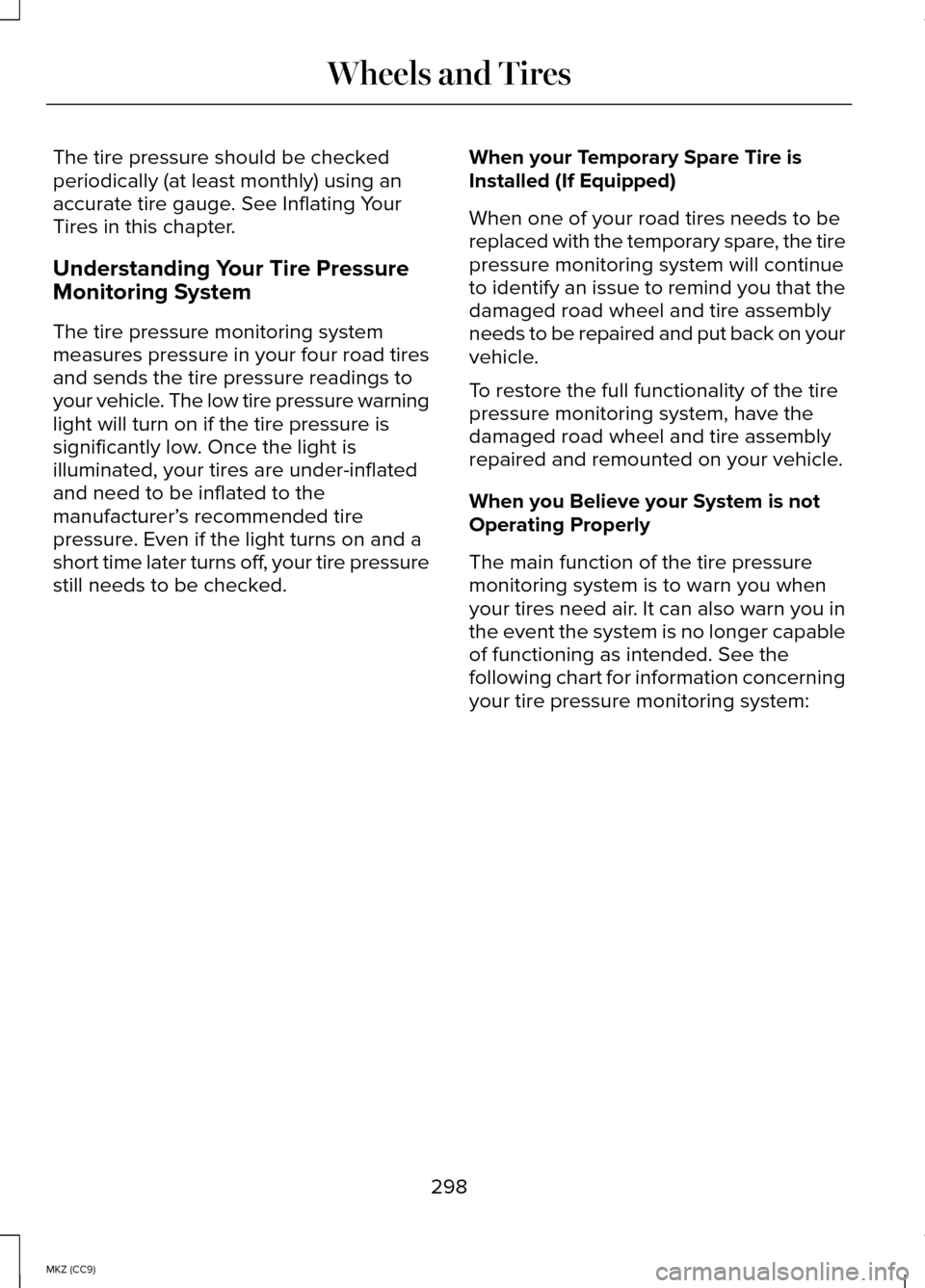
The tire pressure should be checked
periodically (at least monthly) using an
accurate tire gauge. See Inflating Your
Tires in this chapter.
Understanding Your Tire Pressure
Monitoring System
The tire pressure monitoring system
measures pressure in your four road tires
and sends the tire pressure readings to
your vehicle. The low tire pressure warning
light will turn on if the tire pressure is
significantly low. Once the light is
illuminated, your tires are under-inflated
and need to be inflated to the
manufacturer’
s recommended tire
pressure. Even if the light turns on and a
short time later turns off, your tire pressure
still needs to be checked. When your Temporary Spare Tire is
Installed (If Equipped)
When one of your road tires needs to be
replaced with the temporary spare, the tire
pressure monitoring system will continue
to identify an issue to remind you that the
damaged road wheel and tire assembly
needs to be repaired and put back on your
vehicle.
To restore the full functionality of the tire
pressure monitoring system, have the
damaged road wheel and tire assembly
repaired and remounted on your vehicle.
When you Believe your System is not
Operating Properly
The main function of the tire pressure
monitoring system is to warn you when
your tires need air. It can also warn you in
the event the system is no longer capable
of functioning as intended. See the
following chart for information concerning
your tire pressure monitoring system:
298
MKZ (CC9) Wheels and Tires